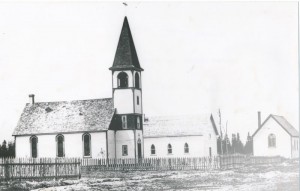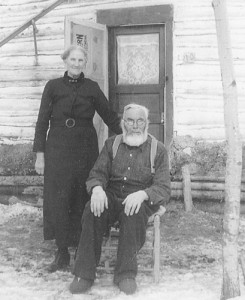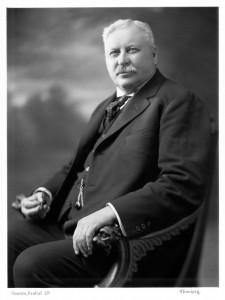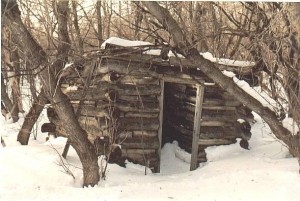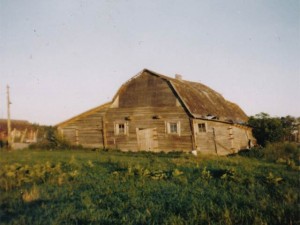Author Archive: ldbhistorical
2015 Annual Wine & Cheese
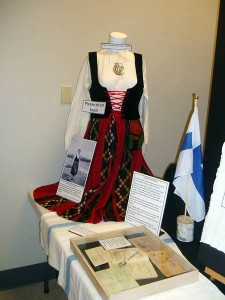 This year the Lac du Bonnet & District Historical Society celebrated a tribute to the Finnish settlement in our region on Friday December 4 at the Lac du Bonnet Community Center.
This year the Lac du Bonnet & District Historical Society celebrated a tribute to the Finnish settlement in our region on Friday December 4 at the Lac du Bonnet Community Center.
Leno Knox, the daughter of Finnish immigrant Pete Livo, who resided in Pointe du Bois, gave a wonderful speech on the Finnish history to the attentive audience of 155+ people. Leona also had on display the costume her mother Alli Livo (see Photo) brought with her when she arrived in Canada in 1928, her Transatlantic ship boarding pass and her passport, along with other memories.
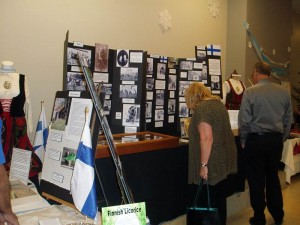 Miriam Simoens a decendant of the Tuokko Family, raised on Pinawa Bay, also had a Finnish Costume on display, along with a table of more current items from Finland. Miriam played a very important role in baking traditional Finnish breads and desserts which were combined with other Finnish desserts made by Iona Plato.
Miriam Simoens a decendant of the Tuokko Family, raised on Pinawa Bay, also had a Finnish Costume on display, along with a table of more current items from Finland. Miriam played a very important role in baking traditional Finnish breads and desserts which were combined with other Finnish desserts made by Iona Plato.
The Lac du Bonnet District Museum displayed photographs of early Finns from Elma, Whitemouth, Newcombe, Riverland, Pointe du Bois, and Pinawa Bay.
The displays were overwhelmed with onlookers, photo takers, memories, and information.
Entertainment this year was “storyteller” Kay Stone with a tale of the Kalevala chapter Lemminkainen the trickster and Don MacLellan on acoustic guitar
89 pounds of food was collected at the door and donated to the local food bank. Silent auction, rainbow auction, and 50 / 50 draw were held to raise funds for the Lac du Bonnet and District Historical Society.
We would like to thank local businesses, members, and everyone who generously donated prizes and their time to make this event a success.
Finland is a Nordic country in northern Europe bordered by Sweden to the west, Norway to the north, and Russia to the east.
Unrest with the Russian occupancy of Finland Tsar Nicholas 11 's February Manifesto of 1899, combined with Canada's Minister of the Interior Sir Clifford Sifton's advertising free homesteads in western Canada initiated a great exodus of Finns from Finland.
The Finns came to the USA then spread across the prairies favoring SE Saskatchewan "New Finland".
The late 1890s saw Finns settle in Whitemouth and Elma. Later they settled in Newcombe, Riverland, Pinawa Bay, Lee River, and Pointe du Bois.
Newsletter 2015
2014 Annual Wine & Cheese
December 5th , 2014
“Bienvenue: our French heritage was the theme of our Annual Wine & Cheese Fundraiser at the community center. The weather certainly cooperated with us, as we had a full house of guests coming from all areas within the RM of Lac du Bonnet and beyond. Many new faces along with familiar faces enjoyed the evening of historical displays, entertainment, draws, fabulous French wines, and delicious foods featuring Sucre a la Crème.
Our French history focused around the areas of Maple Creek, Landerville, Crescent Bay, and of course Lac du Bonnet. For detailed information of the French settlements in these areas be sure to check our tab, titled “History and Stories” on this website.
 One of the displays featured George Veilleux’s christening gown from 1923. George and his family were long time residents of Lac du Bonnet. Joseph George Albert aka “Chief” Veilleux (1923-2001 )was a WW11 Vet ,City Hydro, and Natural Resources employee.
One of the displays featured George Veilleux’s christening gown from 1923. George and his family were long time residents of Lac du Bonnet. Joseph George Albert aka “Chief” Veilleux (1923-2001 )was a WW11 Vet ,City Hydro, and Natural Resources employee.
 Also displayed was a wonderful log cabin quilt made by the Roman Catholic Church ladies auxiliary for raffle during a card party . Maria David won the quilt and later passed it on to Evangeliste David in 1940.. This quilt was on loan from Laurentine Fournier for the evening. Louise Ylonen was generous enough to loan us a primitive hand carved chair and frame done by Jean Baptiste David who settled in Crescent Bay area during the depression.
Also displayed was a wonderful log cabin quilt made by the Roman Catholic Church ladies auxiliary for raffle during a card party . Maria David won the quilt and later passed it on to Evangeliste David in 1940.. This quilt was on loan from Laurentine Fournier for the evening. Louise Ylonen was generous enough to loan us a primitive hand carved chair and frame done by Jean Baptiste David who settled in Crescent Bay area during the depression.
Our special MC’s for the evening were Marie Hiebert and her father Archie Cing- Mars who spoke to the audience in both English and French .
Our wonderful entertainment consisted of Erin Okrainec who is an 11 year old Fiddler from Winnipeg. She has been playing the violin for just over 4 years. She has placed 1st in “10 and under” at the Manitoba Open 2013 Fiddle Contest and 2nd at the International Old Time Fiddlers Contest 2014 “Junior-Junior Division” held at the International Peace Gardens. Erin loves playing Old Time Fiddle Music.
“Old time has a fun swing, with lots of change-ups. When I play it, I just want to dance and smile.”
 Also playing some great French tunes were The duo “1 Plus 1” comprised of Ed Courcelles and Guy Lacroix. Ed hails from Pine Falls/Powerview and Guy from Lorette. Both now live in the Lac du Bonnet area and have taken to music as a retirement activity. They entertain in both English and French and have been regulars for years at various venues in the Franco-Manitoban community such as the Festival du Voyageur.
Also playing some great French tunes were The duo “1 Plus 1” comprised of Ed Courcelles and Guy Lacroix. Ed hails from Pine Falls/Powerview and Guy from Lorette. Both now live in the Lac du Bonnet area and have taken to music as a retirement activity. They entertain in both English and French and have been regulars for years at various venues in the Franco-Manitoban community such as the Festival du Voyageur.
The event proved to be another great success and we especially thank the many French descendants who so willingly dug deep into their history and old photos, allowing us to tell their stories, and our local businesses and volunteers for their continued support.
Sucre à la Crème
- 1 C. heavy whipping cream 35%
- 1 1/2 C. brown sugar 1 1/2 C. white sugar
- 1 tbsp. butter 1 tsp vanilla a pinch of salt
- Boil cream & sugars together on medium heat stirring constantly until soft ball stage .
- Remove from heat and stir in vanilla & salt. Stir approx. 3 mins. to cool down , then add butter. Stir vigorously until thickened like gravy.
- Place into parchment lined 9 x 9 pan and let cool about 2 hours.
Maple Creek, Landerville, and Crescent Bay
The French were the first Europeans to penetrate the western region of Canada and extend their sovereignty and institutions onto the prairies. They were the first to come into this native territory, the first to establish commercial relations, the first to establish a military presence, and the first to establish missions and schools.
Pierre Gautier de Varennes, Sieur De La Verendrye, and his sons had a dream to discover the “ Western Sea” and between 1731 and 1739 they were active in building the first trading posts on the prairies promoting the fur trade and gathering information and pushing back the frontiers of New France as far as Manitoba. Under their watch much of the fur trade was diverted to the St. Lawrence River from Hudson Bay. La Verendrye was credited with the naming of our lake, as it resembled the shape of a bonnet.
It was 160 years after La Verendrye that a number of French Canadians either from Quebec or Acadie came to this area. A number of them lived in the United States prior to moving to the Lac du Bonnet area. About 1899 some of these early French settlers obtained work with the Lac du Bonnet Mining, Manufacturing, and Developing Company under Walter Wardrop, and later J.D. Mc Arthur. Under this company they built and worked the brick factory and sawmill. Work was also obtained at the Pinawa Dam.
Religion and the church are very important to the French communities. Father Louis De Gonzague Belanger is credited with building the first Notre Dame du Lac Parish in Lac du Bonnet. The building was constructed in 1904 with the help of Louis Bruneau and other church members. Lac du Bonnet’s first school was opened in 1903 -1904 with the school being bilingual until 1916.
Many settled in and near the village of Lac du Bonnet, whereas other French families homesteaded in surrounding districts known as Maple Creek, Landerville, and Crescent Bay.
Maple Creek
is a district about 12 miles NW of Lac du Bonnet, homesteaded mainly by the French settlers.Maple Creek was named after the large number of huge Manitoba maple trees (Box Elder) along the banks of a small creek that twisted and turned through the district emptying into Crescent Bay (before Mc Arthur Dam).
Settlers were attracted by the offer from the government for $10.00 homesteads consisting of 160 acres. At this time there were no roads and it took two days from Lac du Bonnet by wagon through swamp and bush. Small mixed farming was done in Maple Creek, with men taking on extra work in bush camps cutting pulp.
Francois and Marie Lussier were two of the earliest homesteaders in 1919. Omer Lavoie operated a small sawmill in Maple Creek, and Mr. and Mrs. Henry Belair operated a small store on their farm until they moved to Lac du Bonnet in 1950.
In 1937 while Maple Creek School was being built across the road from the Lussier farm, a temporary school was held in their former log home. The new school was built by Edgar Paul, Armand Tetrault, and Noel Henri. It was used until 1965 after which the rural school children were bused to Lac du Bonnet.
Lussiers old log cabin then became a chapel where a priest would come on a mission during the months, when the weather was favorable, to hold baptismal and mass.
Maple Creek Cemetery is located on the Francois Lussier homestead farm and holds graves dating back to 1930.
Landerville
is a district about 7 miles NW of Lac du Bonnet. The area was first settled by a majority of Ukrainian and Polish settlers as early as1905 with some French families homesteading by 1910.
Landerville School and teacherage were built about 1918 with Mrs. Henley as the first teacher. Landerville also had a community hall, at the corner of Landerville and Maple Creek road, and a small country store run by Bill Kabaluk, across from the school yard.
Landerville Cyclone May 10, 1922
The weather was a dull grey prior to the lunch period. It looked like a storm was brewing over the small community of Landerville, seven miles north of Lac du Bonnet. About 1:30 pm all fury broke out. As the cyclone uprooted nearby trees, moved Landerville School off its foundation, and totally demolished the teacherage.
“ I was playing outside with my cousin Jean, who was about my age. Suddenly the sky became very dark and a wind came up. Then we noticed a huge dark V-shaped cloud complete with large raindrops. We were rather frightened and about to go indoors, when we heard frantic cries up the road. One of our cousins, Francis, A boy from the school, was hysterical and telling us that everyone at the school was dead. Immediately the men and whoever could help rushed to the school. They found that a cyclone had smashed Uncle Stanley’s house and lifted the school from its foundation”.
Stanley Pitre was the school teacher at the time.
An excerpt from Marcel Pitre’s book “Pitre Family Reunion July 1999
Crescent Bay
is about 6 miles north of the village of Lac du Bonnet named for the crescent shaped bay on the west side where the Winnipeg River expands to form Lake Lac du Bonnet.
Crescent Bay School was constructed in 1934 with Miss Ann James as the first teacher. French families that settled in this district were Bruneau, Picard, and David among others.
A large portion was flooded in 1953 when Mc Arthur Falls Power Plant began operations.
JD McArthur
J.D. McArthur, Veteran Builder of West, Dead (obituary)
Source: The Winnipeg Evening Tribune, vol. 3 no. 8, 10 January 1927.
Submitted by Lorraine McIntosh, Lac du Bonnet
Passes Away in Private Car on Reaching City From Battle Creek Sanitarium
J.D. McArthur, president of the J.D. McArthur Co., Ltd., and vice-president of the Manitoba Paper Co., pioneer railway builder of Western Canada, died this morning in Winnipeg.
He had just returned in a special car on the Great Northern train from Battle Creek, Michigan, where he had been undergoing treatment for the past few weeks. Death overtook him in the special coach half an hour after the train pulled into the city, the scene of his activities for the past 47 years. He was in his 74th year.
For some time Mr. McArthur had been suffering from acute anaemia. A few weeks ago he left for the sanitarium at Battle Creek. After a period of treatment there, hope for his recovery was given up. On Saturday morning, accompanied by Mrs. McArthur and a special nurse, he was placed on board a private car, provided by the Michigan Central Railway, to return to Winnipeg. At Chicago the car was transferred to the Great Northern train, which arrived here at 9:05 o'clock this morning.
When he left the sanitarium at Battle Creek it was with the understanding that everything possible had been done for him there. The body is now at Thomson’s Funeral Home. Arrangements have been made for the funeral Wednesday afternoon. A private service will be held at the family residence, 159 Mayfair avenue. At 2:30 o'clock a public service will be held at St. Augustine Church. Burial will be in St. John’s Cemetery.
His Life Work
John Duncan McArthur is generally believed to have built more miles of railroad than any other man in the history of Canada. Besides building about 250 miles of the then Grand Trunk Pacific between Winnipeg and Lake Superior Junction, some of his other large contracts included about 500 miles for the Canadian Pacific Railway and a long stretch of the then Canadian Northern Railway between Portage la Prairie and Edmonton. He alone was responsible for putting the entire Edmonton, Dunvegan and British Columbia Railway system on the map, an enterprise which entailed laying over 900 miles of trackage. He also built the Alberta and Great Waterways Railway and all but the last section of the Hudson Bay Railway.
Many Interests
He was interested in many business enterprises, being, besides president of the company which bears his name, vice-president of the Manitoba Paper Co., president of the Northwest Lumber Co., president of the McArthur Land Co., director of the Western Trust Co., president of the McArthur Lumber ad Fuel Co., and director of the Beaver Lumber Co.
Although most of his contracts were for railroad work he also erected some very fine buildings, the biggest being the McArthur building here, which he built in 1909–1910 at a cost of $750,000. Other buildings in Winnipeg which he put up are a wholesale warehouse on McDermot ave., 1898; the Breadalbane Apts., 1909; and the Glengarry Block, 1911.
Far Seeing
Mr. McArthur was a big man, not only physically, but in his mental outlook. Where others saw only flat, uninteresting prairie, he saw the future home of countless happy settlers; where others saw forests and streams simply as possible fishing haunts or vacation grounds, he saw thousands of uncut railroad ties, millions of feet of lumber which might be used in the building of a nation. He was a man of vision, an empire builder who loved the country he was born in and spent his life developing its natural resources, bringing vast areas of it within the borders of civilization, and trying by every means within his power to make it great and prosperous.
He was a man of unbounded energy and unswerving purpose, he never once failed to fulfil a contract, he never started anything without carrying it through. So great was the confidence he inspired in others, that it is said that he could go into a bank and borrow a million dollars quicker than any other man in Canada.
He was, what he himself termed, “a one-man plunger,” he never had any partners on his big enterprises, he never asked or allowed other people to invest money in his development scheme. Consequently if they failed, as they sometimes did, no one lost a cent except J.D. McArthur, and he was the last man to worry about such a trifle as losing money.
His heart was just as large as his vision, and he gave away hundreds of thousands for charitable purposes on the distinct understanding that his name was not to be mentioned in any way. He was a great admirer of Sir William MacKenzie, and his one ambition in life was to develop the natural resources of Canada.
He made millions of dollars during the course of his lifetime, but money was merely incidental with him, it came as a result of his tremendous labors, and was at once put back into some development project. He did not put it safely away or convert it into gilt-edged securities. As he himself said, “Someone had to take a chance,” when it came to opening up new and untried commercial projects.
He gambled thousands of dollars in schemes and never grumbled when he lost. His friends never tired of telling of his unflinching cheerfulness and courage in the face of adversity.
Was Poor Boy
Born in July 1853, at Lancaster, Ont., J.D. McArthur spent his boyhood on his father’s farm at that place, and was educated in the local school. He came west in 1879 as a young man of 25, and was soon started in the contracting business getting out ties for the old Manitoba and North-Western Railroad.
His first serious financial reverse came in the late ‘80’s when he was working on a tie contract for the Canadian Pacific Railway. He had by this time acquired the ownership of a saw mill at Birtle, Man., and was counting on sawing his ties and floating them to market down the Birdtail Creek. For some reason or other the creek dried up and young McArthur was left with the ties on his hands.
When he did eventually manage to get them to Brandon, the railway could not use them and he had to sell them to the citizens of Brandon as cordwood. However, he managed to get enough money to pay his debts and then he started in again.
How well he succeeded in getting another nest-egg may be judged from the fact that in Jan., 1889, he returned East and married his boyhood sweetheart, Mary McIntosh, of Lancaster.
Well Established

By this time he was pretty well established as a railroad contractor, and in 1901 he started a saw mill and a brick factory at Lac du Bonnet. The former operated until 1918 and the latter until 1920.
It was at the beginning of the 20th century that he commenced going into the railroad contracting business on a large scale. In 1904 he built 500 miles of the C.N. main line between Portage la Prairie and Edmonton, he also built part of the Manitoba and North-Western, and the CPR Crow’s Nest branch.
In 1906 he built 20 miles of the CPR Teulon branch, 36 miles on the M & NW, and did other work for the CPR which included bringing the railroad from Saskatoon to Asquith, the completion of the Kirkella branch and the Wolseley branch, and extending the Winnipeg Beach line as far as Gimli.
Took on Big Job
It was in this year that he commenced work on 250 miles of the Grand Trunk Pacific Railway (GTP) from Winnipeg east to Superior Junction. This was considered one of the most difficult and costly sections of the whole line, running, as it does, through the most rugged and forbidding part of the Laurentian rock formation. He secured the contract in open bidding against strong opposition, and capable management, coupled with favorable circumstances, enabled him to complete it with a substantial profit.
In this year he opened a sawmill at Atikokan, which he ran for seven years, and then dismantled and sent the machinery to his mill in Edmonton. He also bought the Moyie Lumber Company’s interests at Moyie, B.C. but later sold them.
Having emerged successfully from the GTP contract in 1910, he embarked on another venture which eventually nearly wiped out his entire personal fortune, this being the building of the Edmonton, Dunvegan and British Columbia Railway. He had found himself with an immense and costly construction equipment on his hands, for which there was no work in sight. It was a period of rapid expansion, and money was available in large amounts for development purposes.
Given Charter
Some years before, a charter had been granted by the Dominion Parliament for a railway from the Pacific coast to Edmonton by way of Peace River. The name was the Pacific Northern and Ominica, and the usual cash subsidy had been voted for the first 100 miles, but no construction work had been done. After some negotiations a charter was given to Mr. McArthur under the name of the Edmonton, Dunvegan and B.C. Railway, and he commenced operations.
Notwithstanding the outbreak of the war, the rails reached Spirit River in the fall of 1915. Owing to the financial depression which began in 1913 and which was accentuated by the outbreak of the war, Mr. McArthur did not press his claim for the cash subsidy to which he was entitled as the builder of a colonization railway.
Subsidies were voted and paid to other railways in that period, but not to the ED & BC. Even the subsidy that had been voted for the first 100 miles of the Ominica Railway, to which he was entitled by his agreement, was never paid.
Difficult Times
It was decided that if the district was to be served adequately by the railway it must be extended across the Peace River. The cost of the bridge was nearly a million dollars. The bridge was finished in 1918, and a large part of the grading from the plateau to the west end of the bridge was completed the same year. This was the only piece of railroad construction in America in actual progress during the latter part of the war.
The Peace River crop of 1915 was a good one, but that of 1916 was a failure, yielding little traffic and discouraging development. The war had been in progress for two years, and the pioneers of the district had volunteered in such numbers that production was checked. Immigration, of course, stood still. The result to earnings was disastrous in the case of the ED & BC, as with other railroads. Interest had to be paid, and the earnings were not sufficient to pay it. To meet these liabilities, Mr. McArthur made provision from time to time out of his private means, always expecting that the cash subsidy to which he was entitled would eventually be paid. But this was never done.
No Improvement
Through meeting the losses of successive years nearly all of his personal income was absorbed by the railroad. The condition of the road gradually deteriorated and there came to be a question as to the advisability of operating it any longer. While matters were nearing a crisis, Hon. Sir George Foster, acting premier, in response to an appeal from Mr. McArthur, wrote saying the government was prepared to buy the road.
Mr. McArthur at once started negotiations for the sale of it, but without result. At last came a time when the condition of the road was such that a complete breakdown was imminent.
Obituary from Another Source
JOHN DUNCAN McARTHUR
July 25, 1854 - January 10, 1927
John Duncan McArthur was born on the family farm in Lancaster, Glengarry County, Canada West,(Ontario after 1867), where he grew up, was educated and married Mary McIntosh. At age 25 he came west. and around 1880 was cutting logs in, what is today, the Riding Moun¬tain National Park for his sawmill near Birtle, Manitoba, on the Birdtail River. He worked repairing the rail line of the Pembina branch of the Canadian Pacific Railway (CPR) and gained further experience working on other railways in western Canada. By 1889 he received his own contract to build the Red River Valley Railway from Emerson to Winnipeg.
On February 24, 1898, The Lac du Bonnet Mining, Developing and Manufacturing Co. was incorporated and had commenced harvesting the local resources. In 1901 McArthur purchased the company and its holdings of 810 hectares (2,000 acres) of land and a brick manufacturing plant. He built a sawmill just north of what is now the Town of Lac du Bonnet and, in the following year, opened a logging camp near Old Pinawa.
Between 1898 -1901 McArthur had assisted in the building of the CPR branch line from Molson to Lac du Bonnet which would enable bricks, lumber and fuelwood to be shipped to Winnipeg and beyond. He built the first commercial "High Rise" building in Winnipeg, near Portage Avenue and Main Street, named the McArthur Building, later renamed the Childs Building, as well as other large structures in the city.
In 1905 McArthur contracted to build the Transcontinental Railway line 402 kilometers (250 miles) east from Winnipeg, then west to Edmonton, Alberta and thence to the Peace River country. By 1910 he contracted to build, and later to operate, the Edmonton, Dunvegan and British Columbia Railway from Edmonton to Grand Prairie and also the Alberta Great Waterways Railway from Edmonton to Fort McMurray on the Athabaska River. When several companies declared bankruptcy, McArthur lost $30 million dollars outstanding on his contracts.
In 1911 McArthur contracted to build the first 290 kilometers (180 miles) of the Hudson Bay Railway from The Pas to Thicket Portage in Manitoba.
In 1920 McArthur secured Pulpwood Birth #1 from the Dominion Government and a permit for the Pine Falls power site (Great Falls) on the Winnipeg River, By 1924, with the Canadian National Railway line being built to Pine Falls, he succeeded in buying the land to be occupied by the new paper mill. He then formed the Manitoba Pulp and Paper Co. and became its first president.
At the time of his death, age 72, McArthur was president of the J.D.McArthur Co., the Northwest Lumber Co,, the McArthur Land Co. and the McArthur Lumber and Fuel Co., vice-president of the Manitoba Pulp and Paper Co., and a director of the Western Trust and the Beaver Lumber Companies. He served as Post Master of Lac du Bonnet from October 1, 1906 to September 6, 1923. Considered one of Canada's leading business men, John Duncan McArthur built more miles of railroad than any other Canadian contractor.
McArthur Falls, on the Winnipeg River, and McArthur Street, in the Town of Lac du Bonnet, are named in his memory.
Editorial Commentary
Lorraine McIntosh is the wife of Ramsay McIntosh. JD McArthur sold his holdings in Lac du Bonnet to his nephew, Alexander McIntosh who is the father of Ramsay McIntosh and Grandfather of Paul McIntosh of Lac du Bonnet.
Stories by Kathy Willis
Cooling Food in the Past
At one time, before electricity was available, cooling was not as easy as plugging in the refrigerator. We had an icehouse built of square logs near the shoreline and in the winter ice blocks were cut from the river ice and hauled on a sled pulled by horses and stored with sawdust liberally spread among them in the ice house. In the summer these blocks were used in a wooden ice box in the kitchen. The one ice box I remember was a lovely wooden cabinet with a shelf inside for the ice block and a compartment to store the milk and butter etc. When the ice melted the water ran down a pipe at the back and into a large metal tray on the floor under the unit. Occasionally, the ice would melt faster than anticipated and the water would run over the top of the tray at which time the floor would get a quick wipe down and the tray emptied. Mother, being an expert seamstress, used canvas to fashion a sturdy carrier for the ice blocks. This carrier was also used to haul ice blocks from Winnipeg's Arctic Ice on Langside Street in the trunk of the car once the river supply was exhausted. I remember my Dad being approached by another customer asking where he could purchase such a carrier. Mom could have patented her idea! If this doesn't sound too intriguing, remember that the ice blocks were cut with a hand saw - not a power chain saw!
Do You Remember……….The Summer Kitchen?
Do you have a summer kitchen on your property? Do you remember when it was an important part of summer life? Do you and your family still use your summer kitchen? We don’t and sometimes, I miss the experience. Ours was built by 13 year old Carl Arvid Erickson in l933 and the height of the original doorway indicated he wasn’t very tall. It’s amazing how well it’s stood the test of time.
At this time of year, in years gone by, my family would make a transition from the warm, wood stove heated house along a short path to a one room log summer kitchen. This structure, still standing, had an open ceiling, windows all around and couches, called Toronto couches, along two walls. There was a wood stove with an oven, but certainly not as large a wood stove as was in the house we had left behind. Many trips were made to transfer the condiments, the bread box, the cutlery, extra cooking utensils and spices to the summer kitchen.
In the morning, one would rise, dress and proceed to the summer kitchen. One corner had a washbasin and the toothbrushes and limited cosmetics had been transferred there as well. In the house, Mom was the chief cook and bottle washer but things changed when we “moved” to the summer kitchen. There, Dad took over and coffee would be perking on the stove, sometimes porridge cooking and on weekends, the aroma of bacon and eggs permeated the air as we arrived in the morning.
Many family discussions would take place at the large dining table during meals and plans for the day would be solidified. Water had to be heated on the wood stove before dishes could be washed and put away. You see, we had no electricity! Hence, no refrigeration or light switches. We kept the foods that needed to be cool in a small wooden ice box – a little cupboard with shelves in it and a large container underneath to catch the drips as the ice block melted. One family member had to remember to empty that container morning and evening or be prepared to wipe up the floor if it overflowed!
We used coal oil lamps – special ones for the summer kitchen – to light the small space if we stayed up past dark. Sometimes visitors would drop by and be entertained there as well. All of the windows had screens on them so it was most comfortable with a fresh breeze wafting in off the river. At bedtime, we’d blow out the lamps and walk the short path to the house, to find it was kept cool by being closed up all day.
Now and again a skunk family would decide that the space under the building could serve as a new home and of course, they had to be discouraged in whatever way necessary.
In later years, we were privileged to be the proud owners of a propane stove, complete with 3 burners and an oven and also a small propane refrigerator. We thought we were so modern!
When it came time to preserve the vegetables from the garden, blueberries, wild strawberries and raspberries and even fish if there was more than we could eat, the huge navy blue canner would come out and the perspiration would be evident on Mom’s brow. These canned goods would provide sustenance during the winter once we moved back to the house and left the summer kitchen behind for another year.
Unfortunately, once we had hydroelectricity installed in the house, the summer kitchen wasn’t as important and the moves seemed unnecessary because if it got warm in the house, a fan could be plugged in. Those precious memories are just that now as the summer kitchen seems to have become a storage site rather than a meeting place.
The Smoke House
Memories remain of a fire in the smoke house and golden skinned Goldeye hanging there in the heat. The smoking took a full day, after the fish had been scaled, cleaned, salted and put on hooks. The wood was very important – usually oak or some other hard wood, but well dried and definitely not green wood. The flavour depended on using the correct wood. Consistent temperature of the fire was key and on occasion, many of the fish would have to be rescued off of the shelf below the bar and hooks. Either way, the fish were still delicious and are a delicacy served to Queen Elizabeth. In later years, Mother became the expert and eventually taught us how to do the job.
Stories by Miriam Simoens
Trapping in the 1950's
Jack Tuokko, my Father, became a trapper in order to supplement the farm family income.
His natural affinity for roughing it in the bush made this activity an adventure which he tried to instill in his children. We were all taught how to set and check traps and dress furs for sale. My older siblings would snare rabbits in winter along the bush trails to school. Dad learned how to handle guns while in the Finnish Army and passed that knowledge unto us as well.
Dad would start out on his trap line before day break with his backpack of supplies, compass and knife at his waist, and a rifle slung over his shoulder. It was understood that at times he would be too far down river to make it home at night. However, we were confident of his ability to survive alone in the wilderness. Trap lines criss-crossed somehow, and he would sometimes meet up with fellow trappers. They had an honor code to never steal from another's traps. Shacks were set up along the way that would offer basic shelter from the storms and the night.
Once in late spring with a heavy pack of furs, he tried to take a shortcut home across Pinawa Bay and fell through the ice. He managed to use the sharp point of his knife to slowly pick his way back to safety. Once back on shore, he built a fire to regain his body heat and dry his clothes before continuing home with his pack of furs.
He was often proud of his catch and very good at dressing the skins. One day he arrived home quite excited because he managed to catch one of those elusive wolverines. Artfully hand-made wooden stretchers and forms were used to shape and dry the skins for sale. In spring the local fur man would come to barter for a best price of each piece and then cart them away to the bigger fur market in Winnipeg.
The older boys would accompany him on the trap line sometimes. Albert once decided to go on his own. The lake ice offered him safe passage heading out, then strong winds caught and moved the ice pack leaving him stranded on the far shore. As he waited for favorable weather he ate every morsel of food from his pack, so he staved off hunger by eating and enjoying the muskrats from his catch. We celebrated his safe return home a few days later.
None of us became trappers when we grew up, but that sense of outdoor adventure stuck with us.
Written by Miriam Simoens, and submitted to The Leader
Brightstone
Lac du Bonnet’s early immigration mix has brought people here from many different countries. Let us focus on the Ukrainians who settled in Brightstone, Landerville, and Red Deer.
Ukrainian immigrants came to Canada hungry for land. All the land in the Ukraine was controlled by landlords and divvied up into small lots among a large population. Canada, however, had an open West that was almost totally unsettled. This is what attracted so many immigrants to Canada at the turn of the century: the land rush and the opportunities of homesteading.
The first wave of Ukrainian pioneers settled in Manitoba between 1891 and 1914 coming from Poland, Western Ukraine, and other Eastern Slavic countries. Some of the areas the Ukrainians settled in were Cloverleaf, Cooks Creek, Ladywood, Tolstoi, Vita, Gardenton, Brokenhead, and Brightstone which was eight miles West of Lac du Bonnet. The second wave occurred from 1918 to 1939.
Under the Dominion Lands Policy, homesteading immigrants received one hundred and sixty acres of land for the price of a $10 registration fee. Immediately after they arrived, they set out on years of grueling work. As homesteaders they had to break and clear a certain amount of land every year and get it into production in order to keep their homestead. The homesteaders' specified areas of land had to be cultivated within three years, which meant never-ending and back-breaking labor.
Ukrainians gave the community the name “Brightstone” after a large hill of granite outcropping that shone with the morning dew and the reflection of the sunlight. When they arrived in Brightstone, they had to build a house, often of log or sod construction. Wide spruce logs, maybe four to a wall, would be cut from nearby. And then sod or clay mixed with straw to hold it together would be slapped on to keep the harsh weather out. The more refined houses would have a basic whitewash applied over top of the clay.
They were faced with incredible hardships and bitter cold winters, with summers full of mosquitoes and black flies. A new homesteader would start clearing the land by hand, cutting trees with an axe, burning the underbrush, and clearing roots and stumps with the help of a team of oxen, since horses would have been far too expensive. Food was obtained from the land like berries, nuts, and mushrooms, and from a vegetable garden planted. Game was hunted to supplement the food supply. If the water supply was poor, homesteaders had to collect rainwater or melt snow or take on the grueling task of hand digging a well.. . Farming gradually improved from flailing grain to the thrashing machine of the 1920s.
The railways often provided a much needed source of work and extra income for homesteaders. Many were also forced to work other jobs to get enough money to buy the necessary farm equipment and keep the family and farm going. During the 1920s and 30s up to thirty oxen teams went to Lac du Bonnet to sell wood from the Brightstone district.
The land was the fruit of the homesteaders' labor. They put a lot of blood, sweat and tears into it and sometimes it was generous in return. Other times it took its toll on people. Homesteaders and their families were often separated from friends and relatives and many suffered years of hardship and loneliness. The men often left their wives and children to seek work forty miles away by foot on a section gang or lumber camp or twenty miles to the Pinawa Hydo Power Plant.
One of the greatest difficulties was the absence of roads and bridges. Most trails were impassable when wet. In the autumn homesteaders waited until the ground was frozen before transporting their produce to Lac du Bonnet. The roads were always terrible and it took years for them to be all season. The roads began as trails around swamps, then corduroy roads, and finally ditches and drainage were implemented.
Adversities, however, also bound homesteaders together. Prejudices were lessened as people helped one another. Doors were kept unlatched and lanterns hung at night to guide travelers. And as communities developed, there were sport days, country fairs and a variety of entertainment at the community hall or church.
There was a special bond that was created between the immigrants that came here, opened up the West and farmed it. There was almost a spiritual bond among themselves, and with the earth.
Brightstone began with the establishment of a cemetery, followed by St. Mary’s Polish Roman Catholic Church where in 1936 thirty local families attended, which is approximately 130 people attending service. A post office opened with John Stanko as the first and only postmaster from 1913 to 1944. A one room schoolhouse opened in 1912 with Leona Gorecki as its first teacher. Brightstone school colors were red and white. John Hollop opened the first store in 1919, Jacob Hapko was the coffin maker and barber from 1914 to 1935, and John Malyk was the local Brightstone blacksmith.
A community hall was built in 1925 and in 1937 the Ukrainian Catholic Church was started. The Wojciechowski family had the first horses in the district in 1913, and he was a cooper or barrel maker. The CO-OP store began in 1938 and ran till 1968.
Ukrainian immigrants were profoundly Christian people. The faith was deeply ingrained in them and they brought this deep faith with them when they came to Canada. The Ukrainian settlers brought with them traditional customs and folk lore.
Lettonia, Bird River, and Lee River
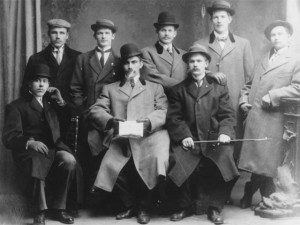
Latvian men in Boston USA 1908 - John Ulman, John Beckman and the Belgin brothers came to Lettonia soon after. ~ photo courtesy of Vivian Nespar
Latvia is a country in the Baltic region of northern Europe. About 1905 there was a failed revolution to over throw the land owners or German Barons by the Latvians to regain control of their own schools and activities. Consequently several thousand Latvians escaped persecution by fleeing to freedom in North America or South America. At that time Brazil, the United States, and Canada were advertising golden lands of opportunity and free homesteads.
The Latvians migrated to Manitoba from Brazil and the United States. Latvian families took up homesteads in Libau, Lettonia, Newcombe, Lee River, Bird River, and Sifton areas from the early 1900’s to the 1930’s.
Homesteads on the river were acquired “sight unseen” due to the lack of roads and the fact that the river was the only way of transportation. It is amazing how one would have to paddle 25 miles into the wilderness to locate their quarter section of land on the Bird River.
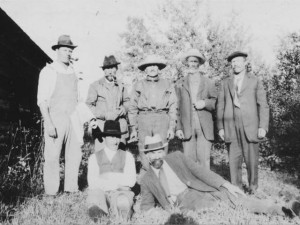
Bird River homesteaders August 15, 1921 - Back row: Ed Peterson, Willis Gulbis, John Ledin, Mikel Osis, George Drawson Sr. Front Row: Lapin Greikst, and Peter Preede. ~ photo courtesy of R.E. Emmett
The homesteaders had to clear land, build a house, and live on the land at least part of the year. Most had to work away for a portion of the year on threshing, trapping, prospecting, laboring at Pointe du Bois, Pinawa Dam, and Lac du Bonnet Brick Works, cutting wood or other jobs.
As an example of the amount of cord wood cut between 1912 and 1920, one mile East of Lee River F. Hestrin & Sons were shipping out 5 or 6 boxcar loads a week. They had 1 thousand cords stacked up awaiting available box cars to ship to Winnipeg at one time.
Newcombe and Lettonia are approximately 10 - 18 miles NE of the village of Lac du Bonnet. This area was settled primarily of Latvians with a sprinkling of Swedes and Norwegians. Lettonia means Latvia or land of the Letts in French. Lettonia was born when the post office was opened in 1913 with John Alksne as first postmaster. John Alksne also donated a portion of his homestead for the Lettonia cemetery.
Eventually small mixed farming commenced, raising cattle, pigs, chickens, sheep, turkeys, and some dairy and fur farming of fox and mink began.
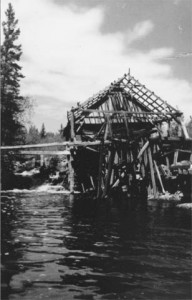
John Peterson’s water powered sawmill at the junction of Bird River and Peterson Creek. ~ photo courtesy of Trethart
John Peterson built a saw mill at the junction of Peterson creek and Bird River that supplied lumber for the surrounding homes. Newcombe school was built in 1915 near Lettonia, Bird River and Lee River school construction followed in 1919 -1920.
John and Annie Mathews donated a piece of land jetting out into the water, not far from their home, where Lettonia Hall was built in the 1920’s. This hall was the centre of activities for people from Bird River, Lee River, and Newcombe for socials, bazaars, plays, dances, and Christmas concerts. A community hall was also built at Lee River.
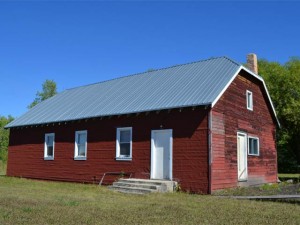
Lee River Hall with kitchen portion removed. From the 20s to the 50s it was the popular spot for weddings, dances, socials, and get-togethers. ~ photo courtesy of Ves Zarins
This hall was a 12 mile sleigh ride from Bird River and had a polished wood floor, a stage at one end, and a kitchen at the other with a balcony overlooking the dance floor below.
Latvians contributed greatly to mineral exploration and the discovery of copper, chromite, and other minerals north of the Winnipeg River in the 1920s to 30s especially Bernic Lake and Bissett areas.
About 1951 their lands were expropriated by Manitoba Hydro for the building of the McArthur Dam for bay. Homes and barns were moved or demolished. The waters were raised 5 meters or 16 feet with a vast portion of Lettonia, Newcombe, Lee River, and Bird River disappearing beneath the waters.
Looking at the Lac du Bonnet District museum 2014 display you can capture our Latvian heritage through photos and artifacts and understand the impact Latvians had in this area. The names Libau, Lettonia, Grausdin Point, Gulbis lake , Osis lake, Anson lake, Sarapu lake, and Lapin Lake bear testament to our Latvian homesteaders.
